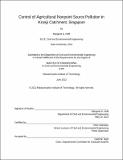| dc.contributor.advisor | Peter Shanahan. | en_US |
| dc.contributor.author | Hoff, Margaret A. (Margaret Ann) | en_US |
| dc.contributor.other | Massachusetts Institute of Technology. Department of Civil and Environmental Engineering. | en_US |
| dc.coverage.spatial | a-si--- | en_US |
| dc.date.accessioned | 2013-12-06T19:51:08Z | |
| dc.date.available | 2013-12-06T19:51:08Z | |
| dc.date.copyright | 2013 | en_US |
| dc.date.issued | 2013 | en_US |
| dc.identifier.uri | http://hdl.handle.net/1721.1/82712 | |
| dc.description | Thesis (M. Eng.)--Massachusetts Institute of Technology, Dept. of Civil and Environmental Engineering, 2013. | en_US |
| dc.description | This electronic version was submitted by the student author. The certified thesis is available in the Institute Archives and Special Collections. | en_US |
| dc.description | Cataloged from student-submitted PDF version of thesis. | en_US |
| dc.description | Includes bibliographical references (p. 78-82). | en_US |
| dc.description.abstract | Singapore's Kranji Reservoir is highly sensitive to nutrient and bacterial pollution, both of which can be directly traced to agricultural runoff. Water quality samples were collected along the main drainage channel in the Neo Tiew subcatchment, which drains to Kranji Reservoir, in an effort to determine the source and degree of agricultural nonpoint source pollution in the area. Grab samples collected from eight sampling locations along the reach of the drainage channel under wet- and dry-weather conditions were analyzed for nitrogen, phosphorus, and bacterial species, as well as total suspended solids. High nutrient and bacterial concentrations were observed at sampling locations in the upstream region of the subcatchment, with total nitrogen as high as 19.8 mg/L, total phosphorus as high as 2.12 mg/L, and a peak total coliform count over 1,000,000 MPN/100 mL. The peak concentration of most of the observed contaminants occurred directly downstream from an intensive row-cropping vegetable production operation. These observations indicate that this farming operation is a primary, though not sole, contributor to nonpoint source pollution in the area. A constructed free-water-surface treatment wetland was designed to treat runoff immediately downstream from the identified source. The designed wetland is projected to remove, depending on flow conditions, between 13 and 99% of influent total phosphorus, 51 to 99% of influent total nitrogen, greater than 99% of influent fecal coliform, and approximately 75% of influent total suspended solids. Agricultural management practices for mitigating runoff contamination are also recommended, including cyclic irrigation and crop rearrangement. It is evident that agricultural nonpoint source pollution is a significant water quality concern in the Neo Tiew subcatchment in particular and the Kranji catchment in general, but there are a number of promising and practical options to address this problem. | en_US |
| dc.description.statementofresponsibility | by Margaret A. Hoff. | en_US |
| dc.format.extent | 90 p. | en_US |
| dc.language.iso | eng | en_US |
| dc.publisher | Massachusetts Institute of Technology | en_US |
| dc.rights | M.I.T. theses are protected by
copyright. They may be viewed from this source for any purpose, but
reproduction or distribution in any format is prohibited without written
permission. See provided URL for inquiries about permission. | en_US |
| dc.rights.uri | http://dspace.mit.edu/handle/1721.1/7582 | en_US |
| dc.subject | Civil and Environmental Engineering. | en_US |
| dc.title | Control of agricultural nonpoint source pollution in Kranji Catchment, Singapore | en_US |
| dc.type | Thesis | en_US |
| dc.description.degree | M.Eng. | en_US |
| dc.contributor.department | Massachusetts Institute of Technology. Department of Civil and Environmental Engineering | |
| dc.identifier.oclc | 862814617 | en_US |
